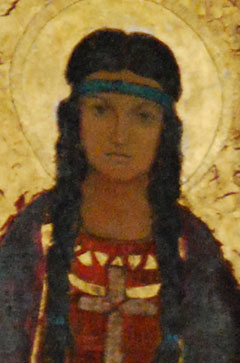Kateri Tekakwitha: A Waste of a Patron Sainthood
(October 6, 2012)
In October 2012, 332 years after her life and death along the New York/Quebec border, Kateri Tekakwitha, Lily of The Mohawks, was canonized by Pope Benedict.
And what is her first assignment as the maiden Native American woman saint? She is patron saint of the environment, go figure.
There's nothing wrong with having a patron saint of environmental stewardship. I would have thought that we had one long before now, perhaps one from among those medieval monks who turned Europe's abandoned and neglected fields into productive farmlands.
However caring for the earth, especially leaving it to grow wild until it strangles us, is not what Kateri was about, not what comes to mind when one learns her life story. Fortunately a saint can be patron of more than one thing.
One of the bullet points of Kateri's biography is that she was treated cruelly as an outcast in her village. Some of the tellings attribute the shunning to her conversion to Catholicism. From what I've read -- the 1690s accounts of Jesuit missionaries who knew her personally -- the ostracism started long before the blackrobes showed up among the longhouses.
Orphaned, disfigured and partially blinded by smallpox, Kateri appears to have grown up being as much a loner as one could be in an Indian village. Certainly the other Mohawk residents had a use for her. Indians needed all the hands they could get to survive. She performed crafting, domestic work as did other women. However she seldom left her longhouse and when she did, she covered herself with a shawl. One reason for this was that sunlight bothered her damaged eyes.
She certainly also had some shame about the pockmarks on her face. Who instilled that shame in her? The other children of the village whom she avoided and to whom she became invisible? Marriage was inconceivable to her; she refused to try to make herself look attractive.
When she converted to Catholicism, she was viewed by many as a reproach to the wicked. They threw stones at her while she walked to daily Mass.
To live in a place where most or all of the people who are like you don't like you. Because you're different in some way that you can't help. That must be quite a cross to bear. Because of this experience Kateri Tekakwitha should be the patron saint of people who are rejected by their own kind.
When the Jesuit missionaries discovered the Mohawk girl with the ravaged skin hiding in the longhouse, they met a teenager who was, to their astonishment, uncommonly receptive to what they had to teach about Jesus Christ.
She was so not because she had been sheltered from evil. She was so because she had faced it from infancy. In Jesus she met one person who had suffered as much as she had.
As a loner who was mortified by life itself, Kateri had never gotten into the types of mischief the other kids did, nor did she become infected by their attitudes and habits. She understood the suffering of the cross. She had been set apart by God, her Jesuit friends wrote after her death, for the special graces that are given to saints. The missionaries were able to connect with her.
So Kateri should also be the patron saint of building bridges to and evangelizing hostile peoples, moreover by way of finding beliefs in common with them. The Jesuit missionaries in Kateri's time began dialog with the Mohawk by building on common concepts. The white man's "heaven" was the Mohawk's "sky world." In our own time we have "Fatima," a word of significance to both Catholics and Moslems. Adnunc venit in dies.
 |
|---|
| Icon of St. Kateri Tekakwitha at St. Patrick's in The City, Washington, DC |
| Copyright 2012 by Neal J. Conway. All rights reserved. About this site and Neal J. Conway nealjconway.com: Faith and Culture Without The Baloney |